The world's leading magazine for all model boating interests

Vane Steering for Model Yachts
Home › Forums › Beginners › Vane Steering for Model Yachts
- This topic is empty.
- Author Posts
I know practically nothing about this subject but am willing to learn.
Now that my RAF launch is nearing completion, I would like to tackle a nice cruising yacht next. As an amateur engineer, the Idea of vane steering is quite fascinating…
If possible, I would install radio as well, plus an auxiliary motor as a back up, My first attempts are unlikely to be successful and I don't want to be stranded mid-lake !
Thanks for any help /suggested reading etc.
Merry Christmas to all,
Vane and other automated steering systems
Auto stering systems like vanes, Braine gear and weighted rudders were intended to prevent steering – their job was to maintain a heading to the wind. So subtle corrections rather than full steering, implying rather different rudder requirements. Radio boats tend to have rather more rudder than self steerers. In either case, the really important consideration is balancing the rig so the boat will at least try to sail straight.
One thing about yachts is that they tend to not get stranded in the middle of a lake. If the air moves, so do they provided they don't have anything to add drag. Of course, having an island in the middle of the lake adds its own uncertanty. Being stranded is different to being stuck.
Edited By Malcolm Frary on 23/12/2019 19:31:52
Thanks for getting the ball rolling Malcolm – you've raised some good points there…
I wonder if anyone has a photo or two showing the actual mechanism(s). Ray and Roy on another thread have given some good descriptions, but, there's nothing like a picture /drawing to aid understanding.
One thing I've noticed about model yachts is the lack of any 'slot' effect – a known powerful aerodynamic driver between a genoa and a mainsail on full-size. Is this because a single sail winch cannot sheet in /out in a co-ordinated way to allow this. Also, how does one manage to 'goose-wing' when going downwind ? Would a vane help to maintain course for this ?
I hope to live and learn,
The model yacht works exactly like a full-size yacht with the slot effect, and yes the jib and main are adjusted proportionally to achieve the same lift from the sail shape to propel the boat forward. It is also easy to sail goosewinged directly down wind with a balanced rig. Take a look at the Dragon Force RG65 if your looking for entry level yacht, these are very popular these days for racing 😀
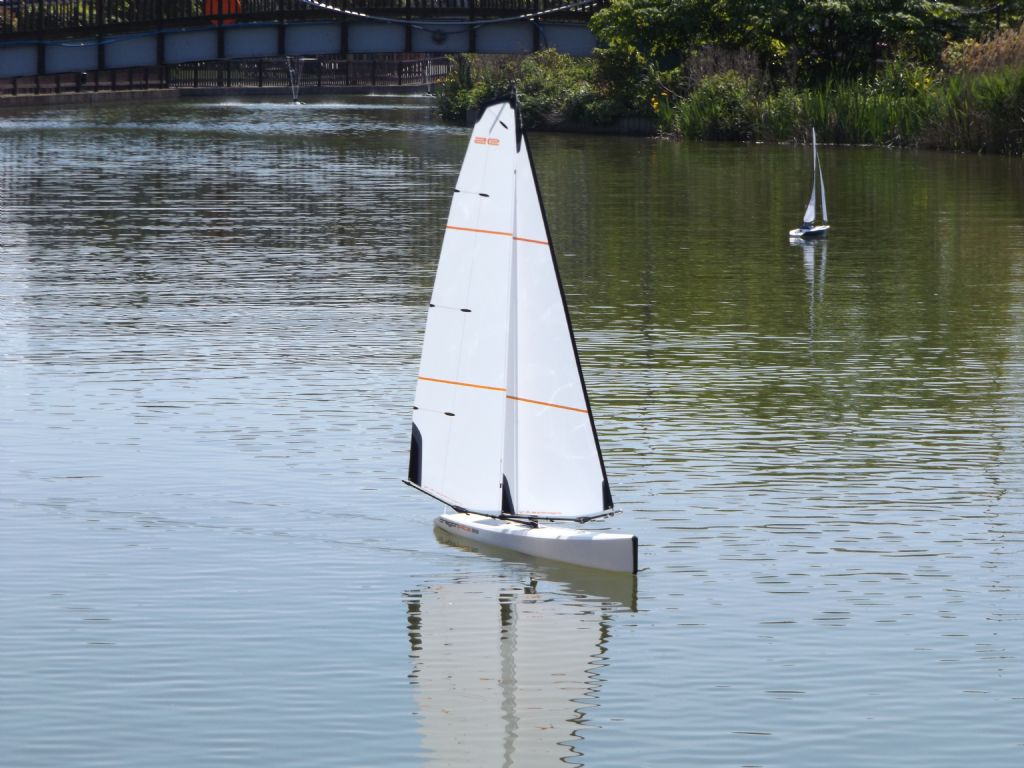
Regards Ray
Edited By Ray Wood 2 on 23/12/2019 20:45:28
I can remember starting a thread on vane sailing some time ago in the Sailing Models section of the site. Attached below is a link. Under the thread 'Vic Smeed's Model Boat Designs' #23 there is a plan for the 25" MM class models Waterbaby and Sea Urchin. The plans show details of making a vane for smaller yachts.
In the Vane Sailing thread the moving carriage vane gear is mentioned, these are a superb piece of engineering, but only suitable for larger yachts e.g. "A" class due to their weight.
I have been following the conversation on the other thread. As has been said already, the development and availability of radio control heralded a major change in model yacht sailing and racing. The sport side is now divided with RC having the much larger participation but Vane racing is still enjoyed by many and some will say this is the sport of the purist.
A vane can be very simple. As a teen I designed and built a 32" model yacht and there was never any thought of being able to afford radio gear. Me and my sailing mate at the time used a plastic gear on the top of the rudder stock and another gear fixed to the shaft of a vane. The vane shaft ran in its own tube just the right distance away for them to mesh. The gear was adjusted by lift the vane to disengage the gear and re-set in the position for the desired point of sailing. It was remarkable efficient but obviously had to be manual changed at each tack. The sophisticated vanes are linked in a way that one setting works for both tacks. This is not the same as "self tacking" as the yachts still needed pushing through the wind at the pondside in order to tack.
Yachts designed for vanes tended to have long overhangs at the stern so that the vane could be operating in clean air and not be back-winded by the mainsail. Mine didn't and it worked OK.
You have set yourself a challenge combining Vane and RC but an interesting one at that. If you are going to have steering connected to an RC servo it will have to be disconnected while using the vane. The boat could easily be one or the other but a bit more tricky to mix both. Or of course you could have two rudders and the vane settings adjustable by RC! I was thinking about this last night. Big yachts have autopilots controlled by a vane at the masthead and sail a course in relation to the wind direction and keep a track of their position by GPS. My Vane yacht probably sailed better to windward than I could have steered it especially at distance when it is hard to see exactly what is going on.
Yes, I can see a bit of a project coming on and some transfer of technology from big boats and model aircraft to sail around a set of way points.
So Dave I am genuinely intrigued.
Stranded mid lake would be a real problem for me as I sail off beaches and open harbours. I always start from the lee shore so the boat would eventually drift back to me. If there is no lee shore I don't sail and should probably go flying.
Hi Ray, Tony and Tim – thanks for the great responses….
I can see that I've got much reading /studying to do already. I think it may be possible to combine vane and RC via some sort of clutch mechanism to disengage one and engage the other – as Tim alludes to, a sort of 'autopilot' system. This would make a cruising yacht nice an relaxing to sail (I'm too old for racing !).
Ray has dispelled my misconceptions over the rig side of things and Tony's links are just right for seeing real mechanisms and designs 'in-the-flesh'.
I must admit, I hadn't considered the sea, or harbours, as potential sailing sites (obvious really !). I'm struggling to find somewhere in North Wilts which is in easy reach.
Best regards,
Any sailplan having more than one sail uses the slot effect, even ones that do not overlap, like the Genoa. Genoas are rare in models because of the extra complication needed to make them work, and extra weight of the gear needed to achieve this, but do exist. Spinnakers also exist, but are rare for the same reasons. Properly set up, the single winch can do nothing but operate the sails in a co-ordinated way (they are both ties to the same piece of string). Some yachts have an extra "twitcher" servo to give some extra adjustment on the jib.
Sail plans that do not have a loose footed (i.e. they have a boom) generally have the lower pivot set back about 1/4-1/3 of the way back, and often carry a leech line. This all ensures that the sail keeps its intended shape, and a side effect is that once you have the wind blowing over the transom, goose winging will happen, probably whether you want it or not.
A kit is a good place to start, even if only to figure out where you would have done better. DF65 has been mentioned, Victoria is very good, and there is a host of 1M long sailboats at very low prices, all of which are a good introduction for somebody who is not scared of improving things.
A simple plan build is also good, a favourite of mine was a free plan in one of the magazines frm the early '90's called "Akela". It reappeared for some time as the "XL 25" on a Dutch site, but that site now seems to have expired. If I did download the plan, I have since managed to misfile it.
Thanks for that correction Malcolm, and the extra information you have given on kits and plans. I'll get to these in due course.
The learning continues…
I am a member of the Vintage Model Yacht Group and have some experience of vane sailing with yachts ranging from 36R sized up to A class. There were a series of articles on vane sailing published in the Turning Pole, the journal of the VMYG a few years ago. I have scans of them and if you send me your email address by private message I will forward them to you,
There are free plans available on the web of an Ezi-build vane gear designed by Graham Reeves. I have attached a photo of the one I built to his drawings.
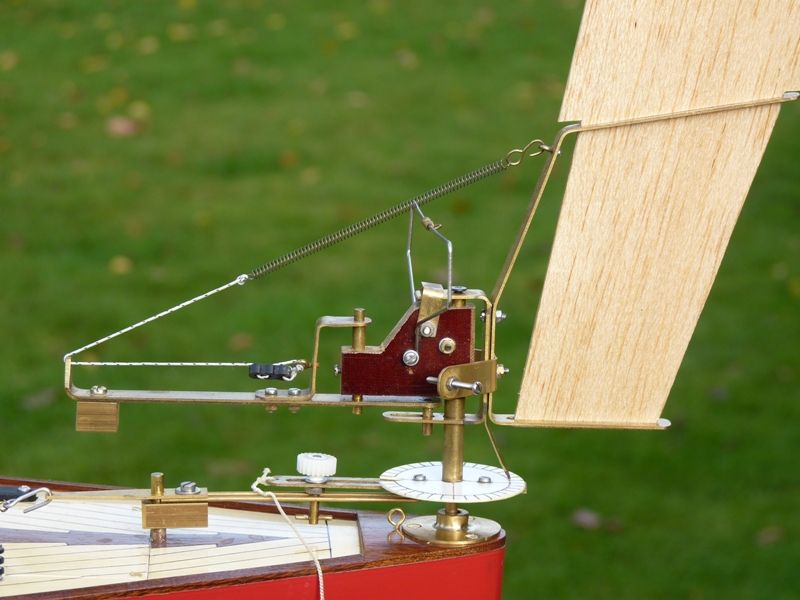
There is a link to the plans on the Llandudno model yacht club site here Vane gear
Dave, there is an introduction to vane sailing on the MYA website and a link to it here Vane sailing
In general vane sailing is done in a straight line from one end of the pond to the other, although the yacht will have to tack from side to side if sailing into wind. It would be quite difficult to combine vane and radio sailing systems on a yacht at the same time and switch between the two, mid lake, so to speak. However it is quite straightforward to modify a yacht so that it can be sailed either as a radio boat or a vane or Braine steered model. Many of the ones that my wife and I own are 'dual control' as there are few lakes near where we live suitable for vane sailing since they don't have the all round access required to cater for the unpredictability of a self steered yacht.
Edited By Gareth Jones on 24/12/2019 12:26:03
Thanks very much Gareth. The photo and links will be very helpful I'm sure. I'll follow up as soon as the Christmas 'bedlam' is over !
Pm sent for the articles.
Compliments of the season to yourself and your wife,
Having studied (but, not necessarily understood ) the posts so far, I think a rough(ish) plan is forming :-
1. Build a yacht big enough to take a vane and radio.
2. Fit a steering servo to the rudder and make the sails 'settable' for all points of sailing.
3. Find a small pond and practice steering with RC – beats, reaches and runs. Go and retrieve it when I lose control.
4. Fit a simple vane and connect it to an Arduino. Drive the steering servo from the Arduino once I've got the programming sorted.
Options /Extras :
Arduino also controls the sail winch as well once the vane 'tells' it which point of sailing the boat is on.
Take the Arduino out of the loop and replace with a sun and planet gear system for steering. A servo would then 'clutch' (lock-up) different segments of the epicyclic gears depending on whether you wanted vane or radio steering.
There must be at least one flaw with this plan !!!! But, I guess the essence of it is moving forwards in progressive steps that I can understand.
Arduino starter set arrives later today (if Santa is on track with this). The epicyclic gears will need some thought and may depend on whether I can source a reasonably priced outer ring gear with internal teeth…
Cheers for now,
Well this will be interesting? I thought model boating was so simple, but maybe not, I learned a while ago never to ask yourself why you do the hobby? It only gets in the way of building the next project 😀
I had to Google Arduino, still non the wiser, is it some sort of Yoga??
Happy Christmas
Edited By Ray Wood 2 on 25/12/2019 07:35:33
You have set yourself a good challenge there. I have also planned to do something similar and bought an Arduino about 18 months ago. My objective was to try and make a self steering yacht with an Arduino processor replacing the vane gear and work up to a completely autonomous yacht that could steer along a straight course, emulating a vane steered model and eventually around a pre-programmed course setting the sails and rudder to the optimum positions. Unfortunately other projects have got in the way and so far I have only got as far as teaching the Arduino to turn an LED on and off. However its still on my list of projects and the Arduino is safely stored in the workshop. I planned to use a China Boy Marblehead as it has plenty of internal space and good access, There are several websites with information that would be useful to you.
At the moment I can't find my scanned copies of the Vane School articles and I might have to rescan them so it could take a couple of days to get them to you.
An Arduino is a small programmable processor that can be built up by linking it to other electronic modules. These can include sensors such as a compass, Global Positioning Systems, temperature, wind direction and also actuators like servos and motors The programming is also done in a modular way with lots of free to use modules available on the internet. There are lots of simple projects available on the web to get started with.
Thanks Gareth,
Sounds very clever, well above my aspirations 😀 simple is good in my book.
All the best
Hi Ray /Gareth – I like simple too. I think the secret with these more complex projects is to break them down into manageable and understandable chunks. (It also makes testing and maintenance easier)…
My long-term aim would be to 'drive' the boat away from the bank, then set it on a heading /course by RC. Then switch to vane to hold that course until it gets to the next 'mark', whereupon, I switch back to RC to set a new heading. etc. etc.
Of course, as Gareth says, you could do all this with Arduino (or, any other microcontroller come to that) linked to GPS – but, that wouldn't be half as much fun. After all, I want to have some say in what the boat does in real time !
Anyway, Santa has done his stuff and I now have a brand new Arduino Starter Set (courtesy of Elegoo and my relatives….)
Ray : If you want to have a play, the set comes with it's own CD and everything you need to complete a whole range of projects – LEDs, stepper motor, servo, etc. I think it's quite inexpensive for what you get (around £30 ?). It helps if you've done a little bit of computer programming, but, I can send you code samples to do simple things like turning nav' lights on and off etc.
Merry Christmas,
My plan was slightly different but also based on a staged approach
Step 1 was was to restore the yacht, which was essentially a wreck, and make it a dual control, radio or vane steered yacht. This was done and it was initially sailed under radio to get the basics sorted out and the mast in the right place. Then it was sailed as a vane boat, including a weekend at Fleetwood in their Vintage Marblehead competition. After about 20 trips each way down the pond over the weekend it was reasonably sorted and there is a picture of it below.
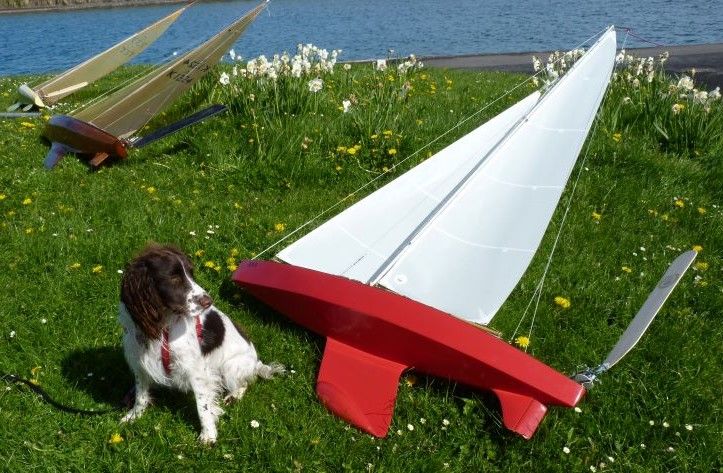
The next step is to fit the Arduino with a data logger and sensors to monitor what the boat is doing when being vane steered. Planned sensors are position by GPS, compass heading, rudder position to see what the vane gear is commanding and wind direction.
The third step is then to remove the vane gear and program the Arduino to try and emulate the vane gear. Its important to realise that the vane gear only attempts to maintain a constant heading relative to the wind direction and its a big assumption that the wind is blowing in the same direction all along the course you want to sail. One of the big advantages of the lake at Fleetwood is the wind is reasonably true. If you are trying to make adjustments to a vane steering system and the wind is being deflected by trees or other obstructions it gets very confusing and frustrating.
The next step is to develop the step three control system so it could be applied when tacking upwind.
The fifth step is to go one step beyond what a vane gear can do and that is to steer a course on a constant heading, in all directions relative to the wind.
Finally the aim is to get the control system to be able to sail a programmed course which would mean the Arduino would have to take control of the sailwinch as well as the rudder.
Hopefully I will make some progress on the project this year but I have got lots of other things to do so maybe it will stay on the shelf for a while longer.
Interesting stuff. Hoping it won't be collecting too much dust.
Presumably you will have to have some kind of apparent wind direction sensor to instruct the Arduino on the sail winch position.
If you have set a compass course and this is not achievable because it is too close to the wind, will you have an auto-tack facility or some kind of alarm that you can no longer hold a particular course so you can make the decision.
I can imagine a "panic" button being useful in case you need to wrest back immediate control!!
Waiting eagerly.
Tim – don't hold your breath, I may be a while getting started.
The great advantage of this control system would appear that is after you have launched your yacht, your can go home and get On with some building 😀 and come back later 😮,
Where's the fun in that??
Nice idea but if it were me I would race it with another yacht.
In fact I could see it as an interesting training tool. Bit like a buddy box.
Gareth has sent me a very comprehensive series of articles on vane steering. Thanks for that Gareth – made very interesting Boxing Day reading…
I think I understood most of it except the 'self-tacking' bit. So, let's say the vane is 'broken' (or, unlocked), what is it that actually initiates changing from say, starboard tack to port ? Also, how does one make it tack a certain number of times before reaching the opposite bank ?
I imagine that wind-shifts, Guying and other fine adjustments to the gear will be involved….(expected hull roll angle ?).
Sorry if I'm being a bit thick here !
I don't think vane gears are self tacking in the sense that they tack themselves. It is more like a dual setting where the vane flips to an identical setting but on the opposite tack. What initiates the tack is the skipper pushing the bow through the wind with a pole. The people sailing the big boats must be very fit to keep up with them on the pond. Me? I would need an electric scooter for sure.
The vane looks after wind-shifts by itself so if the winds heads ie comes closer to the bow, the boat would bear away to keep the angle the same. Choosing when to tack is the big advantage of RC because if the wind heads you should tack and that way make much quicker progress to windward.
- Please log in to reply to this topic. Registering is free and easy using the links on the menu at the top of this page.
Code of conduct | Forum Help/FAQs
Latest Replies
Home › Forums › Beginners › Topics
View full reply list.
Latest Issue
November 2024.
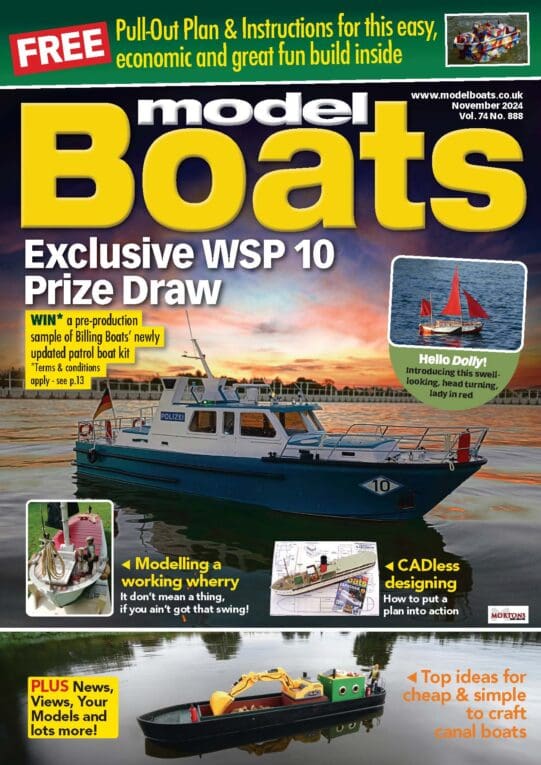
Newsletter Sign-up
- December 2024
- Tin Plate Clyde Puffer
- Reloading Challenges
- Fairey Windscreen.
- Wild Duck meets Eventide
- Calypso motor and ballast queries
- Fairey Fisherman 27 Motor Sailer
- Lysander 17′ Sailing Cruiser designed by Percy Blandford
- Billing Boats Smit Nederland
- The mighty tug Wattle
- Masting, rigging and sails

- Remember me Not recommended on shared computers
Forgot your password?
Pond Yacht rigging
By JerseyCity Frankie May 3, 2015 in Masting, rigging and sails
- Reply to this topic
- Start new topic
Recommended Posts
Jerseycity frankie.
Im sifting the internet looking for information about pre-radio control Pond yacht rigging. Working rigging for sailing scale models.
Before radio control, as I am sure all of you know, pond yachts reached a high degree of sophistication. Self tacking steering gear controlled by wind vanes, with a lot of complex brass hardware with elastic bands and adjustable sliders, were visible on deck and could be set by the user on shore to match the prevailing wind conditions and desired point of sail.
My problem is in finding authoritative information on these mechanisms. Nearly ALL of the images I find of historic Pond Yachts, those not in actual contemporary photos, are of models that have been restored and have had their steering gear simplified, presumably by antique dealers with little working sail understanding. In most of these cases its very obvious that brass fittings remaining on deck are not rigged in a way that would have an actual effect, they have merely been mocked up to look like they function and are often left unconnected to the sails.
Have any of you R.C. guys come across books or websites that deal with this aspect f the hobby? I hope there is a repository of this knowledge somewhere, it would be a shame to lose it.
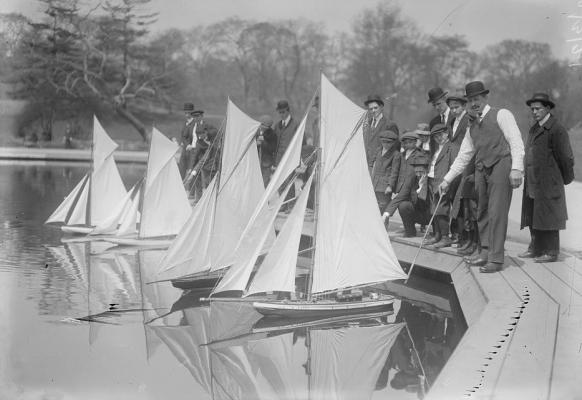
- rshousha , Landlocked123 , Omega1234 and 3 others

Niagara USS Constitution
Blue Jacket Ship Crafters, in their book department sells two books on pond models. Both books are by M. de Lesseps. They are Pond Models and Pond Yachts How To Build And Sail Them. These books may have the information you're looking for.
Yowch $57 on Amazon! But I see only $21 at Blue Jacket. Thanks for the tip!
I wrote to the Central Park Yacht Club and they put me in touch with a gentleman with experience with the subject. I was touched by his generosity when he wrote back and sent along annotations on the photo I had sent him.
He explains that:
......... sheet-to-tiller rig: there were *two* mainsheets, one used on going to windward and the other on the run. Both typically had hooks on the end so they could be switched.
Sailing upwind, the boat sailed on balance only, tiller centered by the elastic as shown in the picture. The beating sheet ran from the end of the boom and was hooked on the ring on the main horse. Running sheet hung loose. On the run, the running sheet would be hooked to the tiller as shown, and run out so the main boom was swung out to one side or the other. The beating sheet would hang loose. The principle is that if the boom were swung to starboard, the boat would tend to turn to port. The pressure of the wind would pull on the main sheet against the elastic and give opposite helm to the rudder , thus guiding the boat. The jib would have a single sheet, adjusted with a tensioning device, let out for the run and pulled in for the beat.
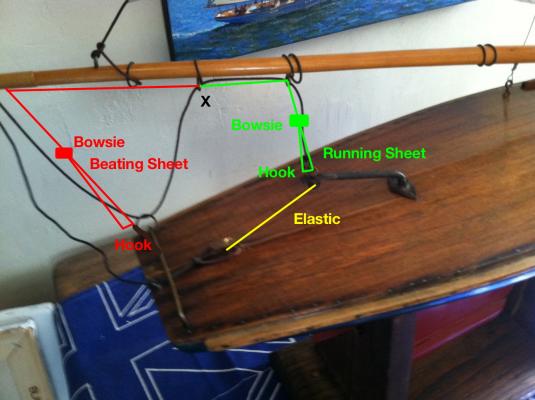
- Landlocked123 , IgorSky , Jack12477 and 2 others
- 2 weeks later...
Found this on Google books and it is relevant: https://books.google.com/books?id=_jYCAAAAQAAJ&pg=PA103&dq=Pond+Models+%C2%A0and+Pond+Yachts&hl=en&sa=X&ei=8NtZVbWuHq7IsQTHgYHADg&ved=0CC4Q6AEwAg#v=onepage&q=Pond%20Models%20%C2%A0and%20Pond%20Yachts&f=false
- 1 month later...
Try this web site from the UK: www.vmyg.uk. Its called the Vintage Model YachtGroup, its web site has a link to a
instruction book for various self steering mechanisms and how they work.
Looked interesting.
Bridgman Bob
Thanks for the link to the website! I thought I had seen them all by now but this was a new one to me. Here are some shots of the model I am restoring, one of two. THis example was likely not actually sailed. It has a lead keel but there is no rudder head, the rudder moves but does not pierce the deck.
The second model, not pictured, has rudimentary self steering gear and I will put up some photos of that later as I finish work on her.
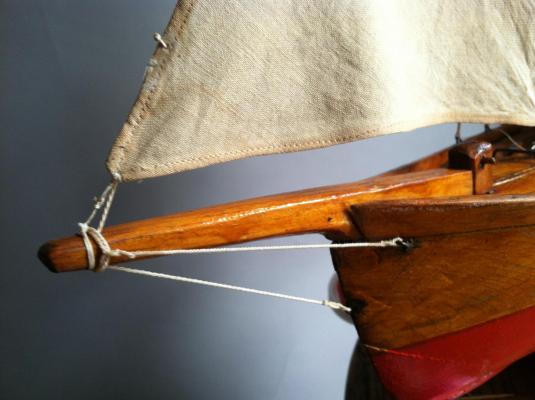
I finished the restoration work I was doing on these two Pond Yacht Models. I have a new appreciation for this type of model and plan on building one of my own now. Here are some before and after photos. ANd then just some details shots.
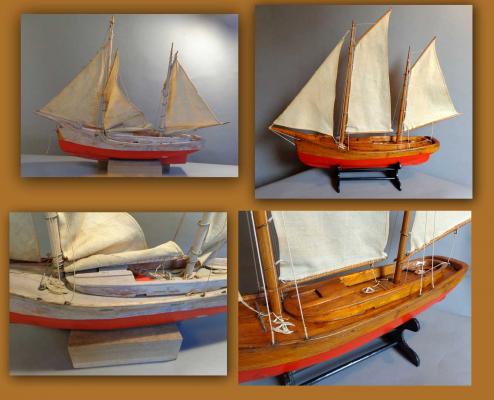
- mtaylor , markjay and Omega1234
- 7 months later...
However, did you notice that shipping at Blue Jacket starts at $50.00?

Huh? http://www.bluejacketinc.com/ordering.htm
Mark "The shipwright is slow, but the wood is patient." - me Current Build: Past Builds: La Belle Poule 1765 - French Frigate from ANCRE plans - ON HOLD Tri ton Cross-Section
NRG Hallf Hull Planking Kit HMS Sphinx 1775 - Vanguard Models - 1:64
Non-Ship Model: On hold, maybe forever:
CH-53 Sikorsky - 1:48 - Revell - Completed Licorne - 1755 from Hahn Plans (Scratch) Version 2.0 (Abandoned)
Join the conversation
You can post now and register later. If you have an account, sign in now to post with your account.

× Pasted as rich text. Paste as plain text instead
Only 75 emoji are allowed.
× Your link has been automatically embedded. Display as a link instead
× Your previous content has been restored. Clear editor
× You cannot paste images directly. Upload or insert images from URL.
- Insert image from URL
- Submit Reply

Recently Browsing 0 members
- No registered users viewing this page.
Modelshipworld - Advancing Ship Modeling through Research
SSL Secured
Your security is important for us so this Website is SSL-Secured
NRG Mailing Address
Nautical Research Guild 237 South Lincoln Street Westmont IL, 60559-1917
Model Ship World ® and the MSW logo are Registered Trademarks, and belong to the Nautical Research Guild (United States Patent and Trademark Office: No. 6,929,264 & No. 6,929,274, registered Dec. 20, 2022)
Helpful links.
- Articles Database
- NRG Home Page
- NRG Online Store
- Important: Our Guidelines
- Terms of Use
- Buildlog Index
About the NRG
If you enjoy building ship models that are historically accurate as well as beautiful, then The Nautical Research Guild (NRG) is just right for you.
The Guild is a non-profit educational organization whose mission is to “Advance Ship Modeling Through Research”. We provide support to our members in their efforts to raise the quality of their model ships.
The Nautical Research Guild has published our world-renowned quarterly magazine, The Nautical Research Journal, since 1955. The pages of the Journal are full of articles by accomplished ship modelers who show you how they create those exquisite details on their models, and by maritime historians who show you the correct details to build. The Journal is available in both print and digital editions. Go to the NRG web site (www.thenrg.org) to download a complimentary digital copy of the Journal. The NRG also publishes plan sets, books and compilations of back issues of the Journal and the former Ships in Scale and Model Ship Builder magazines.
Our Emblem ®
Nautical Research Guild ® and the NRG logo are Registered Trademarks, and belong to the Nautical Research Guild (United States Patent and Trademark Office: No. 6,999,236 & No. 6,999,237, registered March 14, 2023)
- Existing user? Sign In
- Latest Posts
- All unread content since my last vist
- Unread topics I have posted in
- Create New...

IMAGES